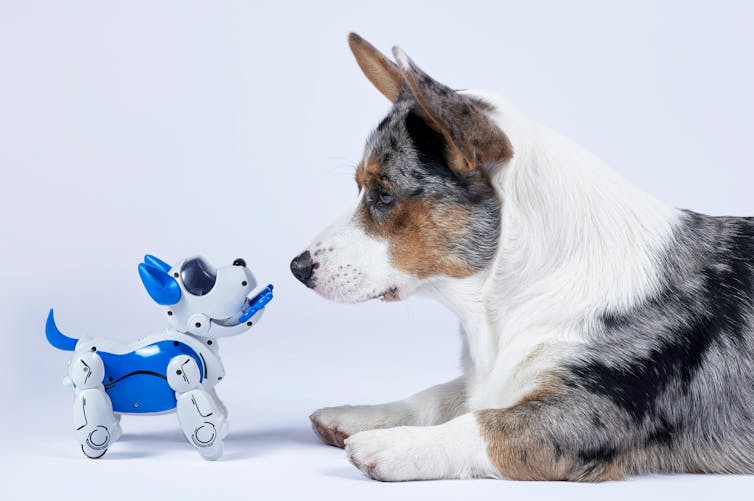Don’t try to replace pets with robots – design them to be more like service animals
August 5, 2021
Share

Robopets are (usually a cat or dog, but they can be any animal). There are numerous robopets on the market right now, being sold to consumers as “pets” or companions. There is an especially fervent effort being made to .
 Animal lovers will tell you they would rather have nothing than have a robot for a pet. While a robopet can be programmed to simulate the actions of a real animal, people know it is fake.
Animal lovers will tell you they would rather have nothing than have a robot for a pet. While a robopet can be programmed to simulate the actions of a real animal, people know it is fake.
There should be a pivot from the companion-based marketing strategy for robopets — which has deep ethical issues associated with replacing emotional bonding between living beings — to address the needs currently being met by service animals.
In my research on the effects of the human-animal bond on human health, participants point out the reciprocal nature of their relationship with pets. The human showers the animal with love, yummy food, cuddles, scratches and pats, and the animal, in turn, responds with unconditional love. The vast majority also say that .
It is condescending to present an adult with a robot and suggest that it will take the place of a loved one — whether that loved one is human or non-human.
New markets
However, there is a huge and, as of yet, untapped market for robopets and other social robots to perform the role of service robots. Let’s call them Serv-U-Bots. These personal service robots are different from those .
Serv-U-Bots would be much like a robotpet — small, portable and intended for personal use — and would employ many of the technologies already built into social robots. These onboard sensors could include cameras for observation, microphones for audio recording, temperature sensors, communication technologies and even autonomous motion, moving around based on programming rather than human input.
Serv-U-Bots would be programmed to replace service animals, which are currently raised and trained to support human mobility and independence. However, this is an expensive endeavour.
Many organizations that provide service animals have breeding programs, training facilities and huge budgets that are subsidized by donors or get charged back to governments, insurers or families. The Canadian Guide Dogs for the Blind graduates approximately 23 dogs per year from its training program, .
These dogs are not considered pets by the organizations that breed and train them. They are service dogs, . If their current placement ends due to death of the person they were helping or for other reasons, they are generally returned to the organization for another placement.
Robots as service animals
But what about replacing service dogs with Serv-U-Bots: social robots that are programmed to perform service related functions? We have the technological know-how to create Serv-U-Bots that can increase independence through programming that can provide an alert if the toast is burning, the kettle boiling, the doorbell ringing and so on. They could even take on the functions of medical alert dogs which can .
Serv-U-Bots could even support older adults to continue to enjoy the companionship of animals by feeding them, checking that they have water and even cleaning the litter box.
If an , why not program a Serv-U-Bot to guide people around the city? They could also be programmed to facilitate actual interactions with living beings. This technology can save and enrich lives and help people to be mobile.
Serv-U-Bots would be able to support the independence and mobility needs of humans without exploiting non-human animals.![]()
__________________________________________________________________________
, Assistant Professor, .
This article is republished from under a Creative Commons license. Read the .
The Conversation is seeking new academic contributors. Researchers wishing to write articles should contact Melinda Knox, Associate Director, Research Profile and Initiatives, at knoxm@queensu.ca.